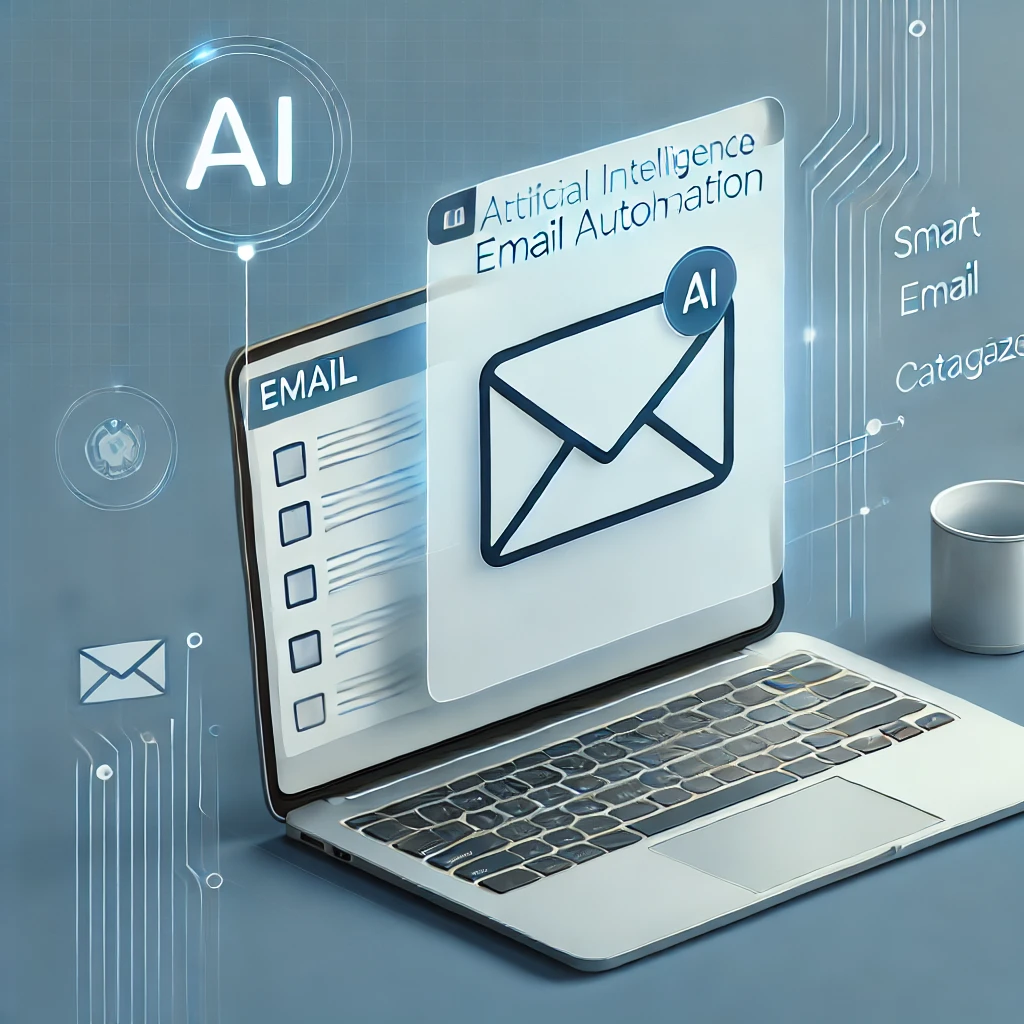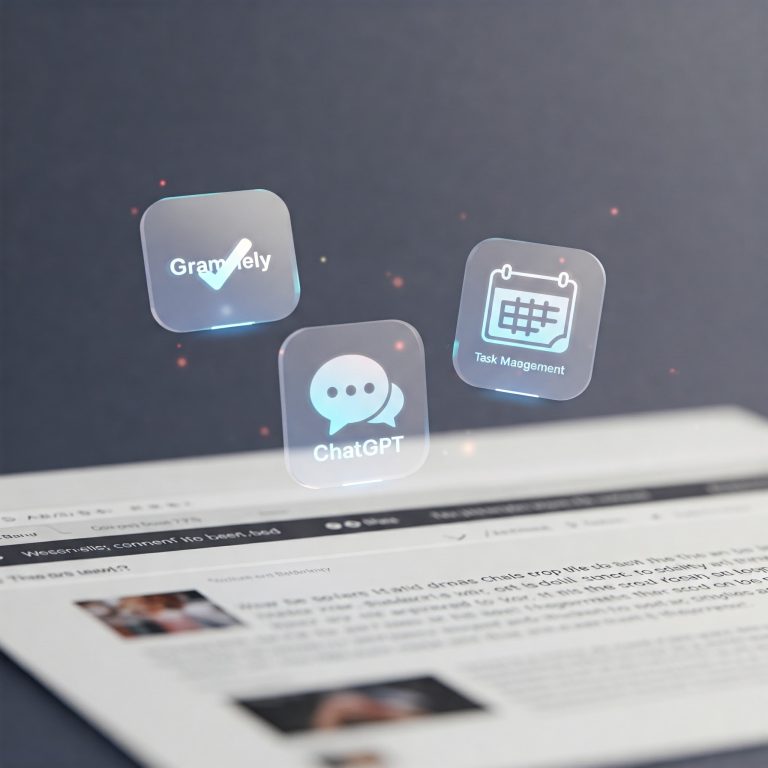In today’s fast-paced digital world, managing email communication efficiently is more crucial than ever. The average professional receives over 120 emails per day, making inbox overload a significant productivity challenge. Sorting through messages, responding to inquiries, and keeping up with follow-ups can consume valuable time—time that could be better spent on strategic tasks.
This is where AI-powered email automation comes in. By leveraging artificial intelligence, professionals and businesses can streamline their email workflows, ensuring prompt, relevant, and personalized responses without manual effort. AI email automation tools use natural language processing (NLP) and machine learning (ML) to generate context-aware replies, prioritize messages, and even categorize emails based on urgency.
Whether you’re a business executive, freelancer, or customer support representative, automating your email replies with AI can significantly boost productivity, improve response accuracy, and enhance user engagement. In this guide, we’ll explore the best AI-powered tools for automating email replies, their key features, and how to integrate them seamlessly into your daily workflow.
By the end of this article, you’ll have a clear understanding of how AI can revolutionize your inbox management, saving time while maintaining a professional and personalized communication style. Let’s dive in!
Why Automate Your Email Replies?
In today’s digital landscape, email communication is the backbone of business operations. However, keeping up with an overflowing inbox can be a daunting task. Professionals spend an average of 28% of their workweek managing emails, which translates to nearly 13 hours per week just reading and responding to messages. This constant email overload can lead to decreased productivity, delayed responses, and even missed business opportunities.
By automating your email replies with AI, you can streamline your workflow, improve efficiency, and enhance communication quality. Here’s why AI-driven email automation is a game-changer:
1. Save Time and Increase Efficiency
Manually responding to every email is time-consuming, especially when many inquiries are repetitive. AI-powered tools can instantly generate smart replies, allowing you to focus on more strategic tasks. Automated responses ensure that routine messages—such as appointment confirmations, FAQs, and follow-ups—are handled efficiently without human intervention.
2. Ensure Consistent and Professional Communication
Maintaining a uniform tone and professionalism across all email interactions is crucial for brand reputation. AI email automation ensures that every response aligns with your preferred tone, whether formal, friendly, or concise. This consistency builds trust with clients, colleagues, and customers.
3. Personalize Responses with AI
Contrary to the misconception that automation removes personalization, AI-driven email tools leverage natural language processing (NLP) to tailor responses based on the sender’s query. These tools analyze context, detect sentiment, and adjust the tone accordingly—offering a more human-like interaction while saving time.
4. Prioritize Important Emails Automatically
Not all emails require immediate attention. AI-powered tools can intelligently filter and categorize emails based on urgency, sender importance, and content relevance. This ensures that high-priority messages are addressed first, while low-priority ones can be handled later or automated entirely.
5. Reduce Human Error and Improve Accuracy
Manually drafting responses increases the risk of typos, miscommunication, and oversight. AI email assistants minimize these errors by generating grammatically correct, well-structured, and contextually accurate responses. This is especially beneficial in industries where precision in communication is crucial, such as legal, healthcare, and finance.
6. Seamlessly Integrate with Existing Email Platforms
Most AI-powered email automation tools integrate with popular email platforms like Gmail, Outlook, and Slack. These integrations enable seamless automation without disrupting your existing workflow. Additionally, some AI tools offer APIs for businesses looking to incorporate automated email responses into their custom CRM systems.
7. Scale Email Communication Effortlessly
As businesses grow, so does the volume of emails. Manually handling thousands of messages daily is unsustainable. AI-driven automation allows businesses to scale email communication effortlessly, ensuring that no inquiry goes unanswered—even during peak hours. This is particularly useful for customer service teams and sales departments.
Top AI Tools for Automating Email Replies
As AI continues to evolve, businesses and professionals are increasingly leveraging AI-powered email automation tools to streamline communication, save time, and enhance productivity. These tools use natural language processing (NLP), machine learning (ML), and smart automation to generate context-aware responses, categorize emails, and optimize email workflow.
Whether you’re looking for a tool to handle quick responses, manage a shared inbox, or fully automate customer support emails, the following AI-powered solutions can help you automate your email replies effectively.
1. ChatGPT (by OpenAI)
✅ Best for: Personalized, context-aware email responses.
Key Features:
- Generates human-like, intelligent responses based on email content.
- Customizable tone and response style to match professional needs.
- Can be used via browser extensions, plugins, and API integrations for seamless automation.
Why Choose ChatGPT?
For professionals who require contextually accurate and personalized replies, ChatGPT is one of the most advanced AI models available. It can draft detailed responses, summarize emails, and even suggest multiple response variations.
2. Google Smart Reply & Smart Compose
✅ Best for: Quick, automated responses within Gmail.
Key Features:
- Uses machine learning to suggest pre-written replies based on email content.
- Smart Compose predicts and autocompletes sentences as you type.
- Seamlessly integrates into Gmail and Google Workspace.
Why Choose Google Smart Reply?
This tool is ideal for quick, one-click responses, especially for users who frequently reply to emails with short confirmations or acknowledgments.
3. Missive
✅ Best for: Teams managing shared inboxes with AI-powered automation.
Key Features:
- AI-assisted email delegation for teams.
- Smart templates for quick, pre-defined responses.
- Collaboration tools for real-time email editing and internal comments.
Why Choose Missive?
Missive is perfect for businesses that require team-based email management while incorporating AI-powered response automation.
4. Flowrite
✅ Best for: Writing professional, structured emails in seconds.
Key Features:
- AI-powered email writing assistant with predefined templates.
- Customizable tone and message structure.
- Best suited for sales teams, HR professionals, and customer service agents.
Why Choose Flowrite?
It’s a powerful tool for professionals who need to generate polished, well-structured email responses without spending too much time crafting messages.
5. Superhuman
✅ Best for: Speed-focused professionals looking for AI-assisted email triage.
Key Features:
- AI-powered email prioritization and smart snippets.
- Ultra-fast email navigation and shortcuts.
- Seamlessly integrates with Gmail and Outlook.
Why Choose Superhuman?
Superhuman is built for users who want speed, efficiency, and AI-powered assistance to stay on top of their inbox with minimal effort.
6. SaneBox
✅ Best for: AI-powered email filtering and inbox management.
Key Features:
- Uses AI to sort, filter, and categorize incoming emails.
- Automatically moves unimportant emails to a separate folder.
- Helps users focus on high-priority messages while reducing email clutter.
Why Choose SaneBox?
If you’re struggling with email overload, SaneBox helps you prioritize important emails and automate the rest, improving productivity.
7. Re:scam by Netsafe
✅ Best for: Tackling scam and phishing emails with AI automation.
Key Features:
- An AI bot that engages scammers in endless, time-wasting conversations.
- Helps users avoid phishing attacks and online fraud.
- Completely free and anonymous service.
Why Choose Re:scam?
If you receive a lot of scam emails, this AI-powered tool ensures that fraudsters waste their time instead of yours.
How to Choose the Right AI Email Tool
With numerous AI-powered email automation tools available, selecting the right one for your workflow can be overwhelming. The key is to evaluate your specific needs and prioritize features that enhance efficiency, accuracy, and personalization. Whether you need quick automated responses, intelligent email triaging, or team collaboration features, here’s how to choose the best AI email tool for your requirements.
1. Identify Your Email Management Needs
Before selecting an AI email tool, assess your daily email challenges:
✔ Do you need quick, one-click replies for frequently asked questions?
✔ Are you overwhelmed by an overflowing inbox and need automated organization?
✔ Do you require personalized, human-like AI responses for professional emails?
✔ Are you managing a team inbox and need collaborative AI-powered automation?
Understanding your pain points helps narrow down tools that align with your workflow.
2. Consider Integration with Your Existing Email Platform
Most AI email automation tools seamlessly integrate with popular email services like:
- Gmail & Google Workspace – Best for Google Smart Reply & Smart Compose.
- Outlook & Microsoft 365 – Works well with Superhuman & SaneBox.
- Business Email & CRM Systems – Consider ChatGPT API & Missive for advanced automation.
Choose a tool that easily integrates with your existing email platform to avoid workflow disruptions.
3. Evaluate AI Capabilities: Basic vs. Advanced Automation
Not all AI email tools function the same way. Some offer basic smart replies, while others provide deep-learning-powered contextual responses.
- For basic automation: Google Smart Reply, Superhuman.
- For AI-generated, human-like responses: ChatGPT, Flowrite.
- For automated email filtering and prioritization: SaneBox.
- For team collaboration on emails: Missive.
If you need fully AI-generated, personalized emails, opt for ChatGPT or Flowrite. If you just need AI-suggested quick replies, Google Smart Reply might be sufficient.
4. Check for Customization & Personalization Features
A great AI email assistant should allow you to:
✔ Adjust tone, language, and style to match your preferences.
✔ Create custom templates for frequently used responses.
✔ Generate personalized responses based on email context.
For instance, Flowrite and ChatGPT excel in personalized AI-generated emails, while Missive allows team-based customization.
5. Assess AI Accuracy & Context Awareness
AI-generated replies should be grammatically accurate, contextually relevant, and free of misinterpretation. Tools like ChatGPT and Flowrite offer highly intelligent NLP (Natural Language Processing) models that understand email context and sentiment to craft professional, natural-sounding responses.
If accuracy and context awareness are top priorities, look for advanced NLP models rather than basic auto-reply generators.
6. Prioritize Security & Data Privacy Compliance
Handling sensitive information through AI-powered tools requires strict data security protocols. Before adopting an AI email assistant, check:
✔ End-to-end encryption for email data protection.
✔ Compliance with GDPR, CCPA, or industry-specific regulations.
✔ No data retention policies for enhanced privacy.
For privacy-conscious users, Superhuman and SaneBox prioritize data security and AI-driven inbox management without storing sensitive information.
7. Compare Pricing & Scalability
AI email automation tools vary in pricing. While some offer free basic versions, advanced features require premium plans.
💰 Free or Freemium Options:
- Google Smart Reply
- Re:scam (for scam email handling)
💳 Paid AI Email Tools for Professionals:
- ChatGPT (Premium API access)
- Superhuman ($30/month for high-speed email automation)
- Flowrite ($8+/month for AI email writing assistant)
- Missive (Pricing varies based on team size)
If you’re looking for long-term scalability, invest in a tool that can handle increasing email volumes as your business grows.
Best Practices for AI-Powered Email Automation
AI-powered email automation has transformed the way professionals and businesses handle communication, boosting efficiency, improving response accuracy, and ensuring timely engagement. However, to maximize the benefits of AI-driven email automation, it’s crucial to follow best practices that balance automation, personalization, and data security.
Implementing AI email automation correctly can enhance customer satisfaction, streamline internal communication, and free up valuable time for more strategic tasks. Below are the best practices for using AI-powered email automation effectively.
1. Set Up Clear Email Response Guidelines
While AI email tools can generate automated responses, they should align with your brand voice, professionalism, and communication policies. Establish:
✔ Tone and style preferences (formal, friendly, or concise).
✔ Response structure (greeting, main message, closing).
✔ Escalation rules (when an email requires human intervention).
For instance, customer service teams should define when AI replies are appropriate and when an agent should take over to provide a personalized experience.
2. Personalize AI-Generated Emails for Better Engagement
A common misconception is that AI-generated responses sound robotic. However, with proper customization, AI tools can generate personalized, context-aware messages.
✔ Use AI-assisted personalization tokens to include recipient names, past interactions, or preferences.
✔ Adjust the tone and formality based on the context of the email.
✔ For critical emails, review and edit AI responses before sending to ensure accuracy.
Example: Instead of a generic “Thank you for reaching out,” AI tools like ChatGPT or Flowrite can craft a more engaging response:
✅ “Hi [Name], thank you for reaching out! I see you’re interested in [specific topic]. Here’s a quick answer to your question… Let me know if you need more details!”
This level of customization boosts user engagement while maintaining efficiency.
3. Regularly Review and Improve AI Responses
AI email automation tools continuously learn from interactions, but they still require human oversight to maintain accuracy and effectiveness.
✔ Monitor AI-generated replies to ensure they remain relevant and appropriate.
✔ Update response templates based on changing business needs or customer feedback.
✔ Analyze performance metrics (response accuracy, engagement rates, and satisfaction scores) to fine-tune automation.
By refining AI responses over time, businesses can ensure better alignment with customer expectations.
4. Use AI as a Starting Point, Not a Replacement for Human Interaction
AI email automation should enhance human communication, not replace it entirely. While AI can handle routine inquiries, scheduling, and basic follow-ups, complex issues still require human intervention.
✔ For critical conversations: Use AI to draft responses but have a human review and refine them before sending.
✔ For emotional or sensitive topics: Ensure that customer concerns, complaints, or high-stakes conversations are handled personally.
Balancing AI efficiency with human empathy ensures a positive user experience and prevents customer frustration.
5. Keep AI Email Automation Secure and Compliant
Since AI email tools handle sensitive communication, security and compliance should be a top priority.
✔ Choose AI tools that comply with GDPR, CCPA, or industry-specific regulations.
✔ Ensure that AI-generated emails do not share confidential or sensitive data.
✔ Enable end-to-end encryption to protect business and customer information.
For businesses handling customer service, finance, or healthcare-related emails, privacy-focused AI tools like SaneBox or Superhuman ensure secure and compliant email automation.
6. Avoid Over-Automation: Maintain a Human Touch
While AI is a powerful tool, over-automating email replies can lead to detached, impersonal communication.
✔ Balance automation with genuine human interaction to prevent customers from feeling like they are talking to a bot.
✔ Ensure high-priority emails are still personally reviewed and responded to by a human.
✔ Use AI-generated suggestions as a guide, but always have the option to customize before sending.
For example, in customer support, AI can handle common inquiries automatically, but complex or escalated issues should be directed to a live representative for a personalized response.
7. Monitor AI Performance and Continuously Optimize
AI email automation should be an evolving process. Regularly assess its effectiveness by tracking key performance indicators (KPIs):
📊 Response accuracy: Are AI-generated replies answering queries correctly?
📊 Engagement rates: Are users responding positively to AI-assisted emails?
📊 Time savings: How much time is AI automation saving your team?
📊 Customer satisfaction scores: Are recipients satisfied with AI-generated responses?
By consistently analyzing and optimizing AI automation, businesses can improve response efficiency and maintain high-quality communication.
Final Thoughts: Embracing AI-Powered Email Automation
As businesses and professionals strive for greater efficiency and productivity, AI-powered email automation has become an essential tool for streamlining communication, reducing workload, and enhancing response accuracy. Whether you are managing a high-volume inbox, handling customer inquiries, or optimizing business workflows, leveraging AI to automate your email replies can significantly improve efficiency, consistency, and personalization.
However, successful AI email automation requires a strategic approach—one that balances automation with human oversight. By following best practices, selecting the right AI email tool, and continuously optimizing performance, businesses can maximize the benefits of AI while maintaining a personal touch in their email communication.
Key Takeaways: Why AI Email Automation is a Game-Changer
✔ Boost Productivity: Reduce time spent on repetitive emails and focus on high-value tasks.
✔ Improve Response Accuracy: AI-powered tools ensure well-structured, grammatically correct, and contextually relevant replies.
✔ Enhance Customer & Team Communication: AI-generated responses provide quick, consistent, and personalized interactions.
✔ Streamline Email Organization: AI can categorize emails, prioritize important messages, and filter out spam.
✔ Increase Scalability: AI enables businesses to handle large volumes of emails efficiently, even during peak times.
By implementing AI-driven email automation, organizations can transform their email management processes—eliminating inefficiencies, improving communication, and ensuring that every email is handled promptly and professionally.
Future of AI-Powered Email Automation
AI in email communication is continuously evolving, with advancements in natural language processing (NLP), deep learning, and contextual awareness making AI-generated replies even more intelligent and human-like. As AI technology improves, we can expect:
🔹 More Adaptive AI: Email automation tools will learn user preferences more accurately to deliver ultra-personalized responses.
🔹 Advanced Sentiment Analysis: AI will better understand tone and intent, ensuring more empathetic responses.
🔹 Seamless CRM & Business Tool Integrations: AI email assistants will become fully integrated into customer relationship management (CRM) software and productivity tools.
🔹 Greater Security & Compliance Measures: AI tools will continue enhancing data protection and regulatory compliance.
The future of AI-powered email automation is not just about saving time—it’s about transforming digital communication into a more efficient, intelligent, and seamless experience.
Are You Ready to Automate Your Email Replies with AI?
If you’re still manually handling every email, now is the time to embrace AI automation. Whether you’re an entrepreneur, a busy executive, or a customer support professional, AI-powered tools can help you:
✅ Reduce Email Overload by automating repetitive responses.
✅ Deliver Professional Replies with minimal effort.
✅ Ensure Timely Responses without missing important messages.
✅ Optimize Your Workflow to increase efficiency and productivity.
Take control of your inbox today by choosing the right AI email automation tool that aligns with your needs. With AI-driven efficiency, human oversight, and a well-structured approach, you can revolutionize your email management and achieve seamless, high-quality communication at scale.
Start automating your email replies with AI today and unlock new levels of productivity!




